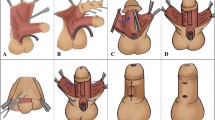Abstract
Purpose
We report the efficacy of staged segmental urethroplasty (SSUP) versus non-staged urethroplasty (NSUP) for treating scrotal/perineal hypospadias (SPH).
Methods
Between 1997 and 2015, 29 SPH patients underwent UP (SSUP: n = 15; NSUP: n = 14). Incidences of urethrocutaneous fistula (UF), stenosis of the neourethra (SNU), diverticula formation, and residual chordee (RC) were compared. Differences were statistically significant if p < 0.05.
Results
The difference in mean age at NSUP (3.2 ± 1.3 years) and at the final stage of SSUP (5.5 ± 2.4 years) was significant (p < 0.05). Mean operative times for NSUP and SSUP (total for all stages) were not significantly different (231.5 ± 117.5 versus 272.5 ± 99.4 min); however, the incidence of postoperative complications was significantly less in SSUP (n = 1; UF) compared with NSUP (n = 6; 2 cases of UF, 3 cases of SNU, and 1 case of RC; (p < 0.05). Mean follow-up was significantly shorter in SSUP; 1.4 ± 1.2 years versus 7.0 ± 4.5 years in NSUP (p < 0.05).
Conclusion
SSUP would appear to be effective for treating SPH because of a significantly lower incidence of UF, SNU and RC during the first postoperative year, the period when complications have been reported to arise most frequently.




Similar content being viewed by others
References
Stanasel I, Le HK (2015) Complications following staged hypospadias repair using transposed preputial skin flap. J Urol 194:512–516
Snodgrass WT, Lorenzo A (2002) Tubularized incised-plate urethroplasty for proximal hypospadias. BJU Int 89:90–93
Hadidi AT (2014) Perineal hypospadias: the bilateral based (BILAB) skin flap technique. J Pediatr Surg 49:218–223
Buskin L, Duckett JW (1994) Dorsal tunica albuginea plication (TAP) for hypospadias curvature. J Urol 151:1668–1671
Yamataka A, Shimotakahara A (2008) Repair of hypospadias with severe chordee using a long, wide, U-shaped flap that preserves ventral penile tissues intact for second-stage urethroplasty. J Pediatr Surg 43:2260–2263
Shimotakahara A, Nakazawa N (2011) Tubularized incised plate urethroplasty with dorsal inlay graft prevents meatal/neourethral stenosis: a single surgeon’s experience. J Pediatr Surg 46:2370–2372
Sunay M, Emir L (2009) Our 21-year experience with the Thiersch-Duplay technique following surgical correction of penoscrotal transposition. Urol Int 82:28–33
Amukele SA, Weiser AC (2004) Results of 265 consecutive proximal hypospadias repairs using the Thiersch-Duplay principle. J Urol 172:2382–2383
Seo S, Ochi T (2015) Soft tissue interposition is effective for protecting the neourethra during hypospadias surgery and preventing postoperative urethrocutaneous fistula: a single surgeon’s experience of 243 cases. Pediatr Surg Int 31:297–303
Kraft KH, Shukla AR (2011) Proximal hypospadias. Sci World J 19(11):894–906
Tiryaki T (2010) Combination of tubularized island flap and ventral skin flap. Urol Int 84:269–274
Cheng EY, Kropp BP (2003) Proximal division of the urethral plate in staged hypospadias repair. U Urol 170:1580–1584
Johal NS, Hamid R (2006) The two-stage repair for severe primary hypospadias. Eur Urol 50:366–371
Elbakry A (2001) Management of urethrocutaneous fistula after hypospadias repair: 10 years’ experience. BJU Int 88:590–595
Shankar KR, Losty PD (2002) Outcome of hypospadias fistula repair. BJU Int 89:103–105
McNamara ER, Schaeffer AJ (2015) Management of proximal hypospadias with 2-stage repair: 20 year experience. J Urol 194:1080–1085
American Academy of Pediatrics (1996) Timing of elective surgery on the genitalia of male children with particular reference to the risks, benefits, and psychological effects of surgery and anesthesia. Pediatrics 97:590–594
Lam PN, Greenfield SP (2015) 2-stage repair in infancy for severe hypospadias with chordee: long-term results after puberty. J Urol 174:1567–1572
Author information
Authors and Affiliations
Corresponding author
Appendix
Appendix

Rights and permissions
About this article
Cite this article
Ishiyama, A., Seo, S., Murakami, H. et al. Staged segmental urethroplasty for scrotal/perineal hypospadias: a new concept. Pediatr Surg Int 32, 403–409 (2016). https://doi.org/10.1007/s00383-015-3844-3
Accepted:
Published:
Issue Date:
DOI: https://doi.org/10.1007/s00383-015-3844-3




